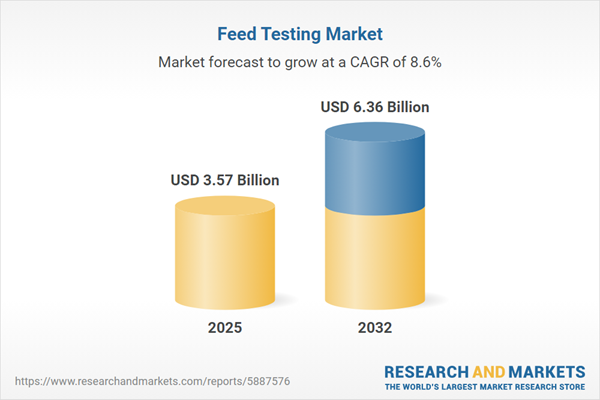Speak directly to the analyst to clarify any post sales queries you may have.
The feed testing market is evolving quickly as companies strive to achieve greater transparency, meet rising quality expectations, and manage regulatory risks. Senior leaders require reliable, actionable insights for strategic choices in risk management and operational efficiency.
Market Snapshot: Feed Testing Market Size and Growth Trends
The feed testing market is entering a strong growth phase, with projected expansion from USD 3.29 billion in 2024 to USD 3.57 billion in 2025, powered by a compound annual growth rate (CAGR) of 8.58%. By 2032, the market is forecast to reach USD 6.36 billion. Key drivers include a shift toward advanced laboratory analytics, increasing digitalization, and more complex global supply networks. Industry participants are adapting to stricter compliance demands, prioritizing safety, and leveraging collaborative partnerships to enhance feed testing quality and access worldwide.
Scope & Segmentation of the Feed Testing Market
Understanding the scope and segmentation of the feed testing market enables senior executives to focus strategies, optimize risk management, and ensure compliance with evolving standards. This research analyzes the core segments as follows:
- Test Types: Chemical analyses evaluate composition such as fiber, moisture, and protein content. Microbiological tests target detection of pathogens and mycotoxins. Physical property tests help verify safety benchmarks throughout global supply chains.
- Technologies: Chromatography delivers highly accurate separation of components, vital for precise feed formulation. PCR methodologies, including multiplex and real-time formats, expedite molecular diagnostics. Spectroscopy, comprising mid and near-infrared techniques, offers valuable non-destructive evaluation for rapid insights.
- End Users: Feed mills utilize these tests for process optimization. Academic research groups develop and refine analytical protocols. Independent and company-owned quality labs verify product consistency and regulatory compliance. Third-party services add audit assurance across the value chain.
- Applications: Testing solutions support the unique nutritional and legal needs of aquaculture, livestock, poultry, and pet food. These tailored applications shape product development, processes, and compliance strategies.
- Channels: Direct sales approaches target high-volume buyers. Distributors broaden reach to diverse regions, while digital marketplaces boost accessibility and facilitate procurement for medium-to-small clients.
- Regions Covered: Coverage includes the Americas (notably the US, Canada, Brazil, and Mexico), Europe, the Middle East, Africa (with specific focus on the UK, Germany, South Africa, and UAE), and Asia-Pacific (including China, India, Japan, Australia, and Southeast Asia). This broad landscape reflects stringent and varied regulatory environments globally.
- Key Companies Analyzed: This study profiles Eurofins Scientific SE, SGS SA, Intertek Group plc, Bureau Veritas SA, ALS Limited, Mérieux NutriSciences, Thermo Fisher Scientific Inc., Neogen Corporation, Romer Labs Division Holding GmbH, and Q Laboratories, Inc., emphasizing their service innovation and sector influence.
Key Takeaways for Senior Decision-Makers
- Laboratory automation and advanced digital interfaces are optimizing quality control, supporting faster, more reliable compliance processes and flexible operations within the feed testing sector.
- Emerging analytics such as multiplex PCR and near-infrared spectroscopy allow organizations to manage higher testing volumes and adapt to more varied formulation and regulatory needs.
- Procurement and investment strategies increasingly value domestic production and adaptable sourcing methods to minimize risks related to global disruptions and cost pressures.
- Implementation of real-time monitoring and IoT-based traceability strengthens supply chain transparency while supporting proactive risk management to align with stakeholder and regulatory requirements.
- Integrated collaboration between feed manufacturers, laboratories, and customers is resulting in tailored compliance solutions and enhanced innovation designed to address both local and global business requirements.
Tariff Impact: US Tariffs on Feed Testing Supply Chains
Recent tariffs introduced by the United States on laboratory and analytical equipment have resulted in increased costs and procurement delays for feed testing stakeholders. In response, organizations are reinforcing operational resilience through sourcing diversification and amplified domestic investment, helping to safeguard ongoing access to advanced, compliant testing technologies.
Research Methodology & Data Sources for the Feed Testing Market
This research draws from interviews with laboratory managers, leading academic researchers, and regulatory experts directly involved in the feed testing supply chain. Additional insights are validated through respected secondary sources, such as sector reports and peer-reviewed publications, creating a robust foundation for sound decision-making.
Why This Report Matters for Business Leaders
- This study supports senior planning by clearly mapping the key industry trends, regulatory developments, and competitive forces that shape the feed testing market.
- Leaders gain the ability to benchmark across segments, identify regional opportunities, and improve strategic alignment for compliance and investment.
- The report enables organizations to anticipate shifts in regulation, adopt emerging technologies, and manage supply networks more effectively in global feed testing operations.
Conclusion
This research delivers actionable intelligence that empowers leaders to address regulatory uncertainty and operational challenges, ensuring strengthened business resilience and long-term growth within the evolving feed testing market.
Additional Product Information:
- Purchase of this report includes 1 year online access with quarterly updates.
- This report can be updated on request. Please contact our Customer Experience team using the Ask a Question widget on our website.
Table of Contents
3. Executive Summary
4. Market Overview
7. Cumulative Impact of Artificial Intelligence 2025
Samples

LOADING...
Companies Mentioned
The key companies profiled in this Feed Testing market report include:- Eurofins Scientific SE
- SGS SA
- Intertek Group plc
- Bureau Veritas SA
- ALS Limited
- Mérieux NutriSciences
- Thermo Fisher Scientific Inc.
- Neogen Corporation
- Romer Labs Division Holding GmbH
- Q Laboratories, Inc.
Table Information
| Report Attribute | Details |
|---|---|
| No. of Pages | 186 |
| Published | October 2025 |
| Forecast Period | 2025 - 2032 |
| Estimated Market Value ( USD | $ 3.57 Billion |
| Forecasted Market Value ( USD | $ 6.36 Billion |
| Compound Annual Growth Rate | 8.5% |
| Regions Covered | Global |
| No. of Companies Mentioned | 11 |









